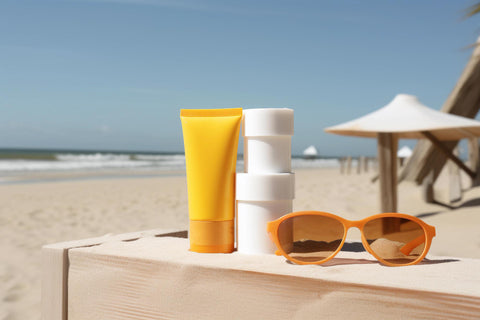Understanding Dry Eye
Dry eye is a condition that arises from various factors affecting the eye’s surface, leading to a disruption in the tear film and resulting in visual symptoms. This means the eye either cannot produce enough tears for hydration or the tears are not efficient in moisturising the eye.
For clarity, the eye’s tear film has aqueous, mucous, and lipid components. Ideally, this film relies on the healthy and harmonious interaction between the tear glands, eyelids, and the surface of the eye, collectively forming the lacrimal unit. Any dysfunction in this unit leads to dry eye, a very common condition.
Symptoms of Dry Eye
You may recognize that you suffer from dry eye, which usually affects both eyes, through some or all of the following symptoms:
- Sensitivity to light.
- Blurred vision.
- The sensation of a foreign body in the eye (sand, dust, etc.).
- Inability to wear contact lenses due to discomfort.
- Watery eyes.
- Eye irritation.
- Redness in the eye.
- A feeling of dryness in the eye.
- Burning sensation in the eye.
These symptoms intensify when exposed to triggering factors such as low humidity or dry weather, strong winds, certain medications like acne drugs, or prolonged use of electronic screens.
Causes of Dry Eye
Dry eye is a common problem that affects a lot of people, especially the elderly, with around one-third of them suffering from it. It's important to note that dry eye can be linked to other health conditions such as diabetes, Parkinson's disease, or Sjogren's syndrome. Certain medications can also worsen dry eye issues, such as allergy medications, antidepressants, or acne treatments.
How to Alleviate Dry Eye Symptoms
In addition to treatment, ensure you follow these tips:
- Avoid prolonged reading or staring at electronic device screens and practice blinking more often (set reminders for this).
- Avoid smoking or being in places with heavy smoking.
- Try using humidifiers in the places where you spend most of your time, like your bedroom.
- Wear sunglasses that cover a good portion of the eye to block dust and wind.
- Do not expose yourself to air conditioning for extended periods and do not sit directly in the airflow.
Who is More Susceptible to Dry Eye?
You are more likely to experience dry eye if you have one or more of the following factors:
- Diabetes, Parkinson’s, or Sjogren’s.
- Hormonal imbalances.
- Women are more prone to dry eyes than men.
- Use of certain medications (antihistamines, anticholinergics, estrogen, isotretinoin, selective serotonin reuptake inhibitors, amiodarone, nicotinic acid).
- Being in low-humidity and dry environments.
- Frequent use of contact lenses.
- Eye surgery.
When Should I Notice Improvement?
You should start noticing a gradual improvement in dry eye symptoms within 3 to 4 weeks. Otherwise, consult a specialist to evaluate your condition or adjust the treatment to better suit your case.
What are the Treatments for Dry Eye?
Dry eye treatment focuses on alleviating symptoms by either increasing tear production, enhancing the completion of tear production stages, slowing tear evaporation, reducing tear absorption, or treating inflammation of the eye’s surface.
During treatment, you will notice an improvement in symptoms, as well as in visual acuity, and protection from potential eye damage due to dryness.
Available Treatment Options for Dry Eye
Artificial tears: generally contain special substances that improve the quality of tears or reduce their evaporation, such as polyethylene glycol, polyvinyl alcohol, or by increasing their viscosity, such as cellulose. They are available in various pharmaceutical forms like drops, ointments, and gels.
Should I Use Drops, Gel, or Ointment for Dry Eye?
Initially, it’s preferable to use eye drops with a dosage of one drop per eye, which can be repeated four times a day. You will notice improvement within a few days, and with continued use of the drops for 3 to 4 weeks, most annoying symptoms should subside.
Gels or ointments can be delayed if there’s no response to drops, and it’s advised to use eye gel or ointment at bedtime as it may cause blurriness in vision.
Can I Increase the Frequency of Eye Drops?
Yes, but only in some cases; if there’s no improvement from using the drops four times a day, you can increase it to six times a day or once every hour. However, it’s recommended to use preservative-free eye drops in such cases.
How to Hydrate When Using Contact Lenses?
Certain specifications must be met for a hydrating drop to be suitable for use with contact lenses. If you do not wish to remove the lenses, you can use Rewetting eye drops specifically for this purpose.
For Example: Oftaial Plus Ophthalmic Solution,Opti Free Solution
If you intend to use a hydrating drop and then wear lenses, ensure that it’s suitable and meets specifications such as being preservative-free, as preservatives may deposit on the lens and cause dryness, irritation, and redness in the eye.
Examples on Suitable eye drops while using contact lenses:
OPTIVE FUSION™ UD
Note: If you frequently use contact lenses, avoid highly viscous eye drops or those that constrict (used to eliminate redness) or drops containing medications for treating infections or diseases. Always space out the use of lenses and drops by at least 15 minutes.
















Comments (0)
There are no comments for this article. Be the first one to leave a message!